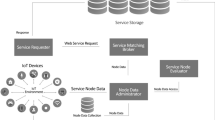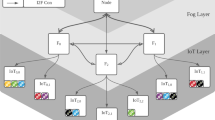Abstract
With the advent of Internet of Things (IoT), cloud service composition problem has gotten more complex along with the composition of large number of cloud services and numerous complex requirements from the users as an NP-Hard problem. In order to compose various cloud services in the IoT context, a conceptual model is required besides an effective selection and composition model. Moreover, as an important aspect of today’s human life necessity, privacy preserving during sharing the data is a crucial concern. Therefore, privacy-aware cloud service composition along with improving the other quality of service (QoS) factors is an essential research motivation especially in the cloud based-IoT environments. In this paper, a privacy-aware cloud service composition approach with respect to QoS optimization in the IoT environment is proposed through presenting an IoT-based cloud service composition conceptual model regarding the privacy level computing model and a novel hybrid evolutionary algorithm using shuffled frog leaping algorithm (SFLA) and genetic algorithm (GA) which is called SFLA-GA. The proposed algorithm is applied to optimize the suggested service composition in terms of aggregation of different QoS factors as fitness value. Also, in order to help the users to select the proper composite service, they are categorized regarding their privacy preserving level which is obtained through a computational model. Simulation results revealed that the proposed approach improves the fitness in comparison to other contemporary algorithms.











Similar content being viewed by others
References
Abedi M, Fathi MS, Rawai S (2012) Cloud computing technology for collaborative information system in construction industry. In: Proceedings of the 18th international business information management association (IBIMA), Istanbul, Turkey, pp 593–602
Aktas MS, Astekin M (2019) Provenance aware run-time verification of things for self-healing Internet of Things applications. Concurr Comput Pract Exp 31(3):e4263
Al-Masri E, Mahmoud QH (2008) Investigating web services on the world wide web. Paper presented at the Proceedings of the 17th international conference on World Wide Web, Beijing, China
Alrifai M, Risse T (2009) Combining global optimization with local selection for efficient QoS-aware service composition. Paper presented at the Proceedings of the 18th international conference on World wide web, Madrid, Spain
Alsaryrah O, Mashal I, Chung T (2018) Bi-objective optimization for energy aware Internet of Things service composition. IEEE Access 6:26809–26819. https://doi.org/10.1109/ACCESS.2018.2836334
Asghari S, Navimipour NJ (2018) Nature inspired meta-heuristic algorithms for solving the service composition problem in the cloud environments. Int J Commun Syst 31(12):e3708
Asghari P, Rahmani AM, Javadi HHS (2018) Service composition approaches in IoT: a systematic review. J Netw Comput Appl 120:61–77. https://doi.org/10.1016/j.jnca.2018.07.013
Asghari P, Rahmani AM, Haj SeyyedJavadi H (2019a) A medical monitoring scheme and health-medical service composition model in cloud-based IoT platform. Trans Emerg Telecommun Technol 30(6):e3637
Asghari P, Rahmani AM, Javadi HHS (2019b) Internet of Things applications: a systematic review. Comput Netw 148:241–261. https://doi.org/10.1016/j.comnet.2018.12.008
Atzori L, Iera A, Morabito G (2010) The internet of things: a survey. Comput Netw 54(15):2787–2805
Blum C, Roli A (2003) Metaheuristics in combinatorial optimization: overview and conceptual comparison. ACM Comput Surv (CSUR) 35(3):268–308
Costante E, Paci F, Zannone N (2013) Privacy-aware web service composition and ranking. Paper presented at the 2013 IEEE 20th International Conference on Web Services
Eusuff M, Lansey K, Pasha F (2006) Shuffled frog-leaping algorithm: a memetic meta-heuristic for discrete optimization. Eng Optim 38(2):129–154
Gavvala SK, Jatoth C, Gangadharan GR, Buyya R (2019) QoS-aware cloud service composition using eagle strategy. Future Gener Comput Syst 90:273–290
Geiger M, Harrer S, Lenhard J, Wirtz G (2018) BPMN 2.0: the state of support and implementation. Future Gener Comput Syst 80:250–262
Ghobaei-Arani M, Souri A (2019) LP-WSC: a linear programming approach for web service composition in geographically distributed cloud environments. J Supercomput 75(5):2603–2628. https://doi.org/10.1007/s11227-018-2656-3
Ghobaei-Arani M, Rahmanian AA, Souri A, Rahmani AM (2018) A moth-flame optimization algorithm for web service composition in cloud computing: simulation and verification. Softw Pract Exp 48(10):1865–1892. https://doi.org/10.1002/spe.2598
Guarda P, Zannone N (2009) Towards the development of privacy-aware systems. Inf Softw Technol 51(2):337–350. https://doi.org/10.1016/j.infsof.2008.04.004
Gubbi J, Buyya R, Marusic S, Palaniswami M (2013) Internet of Things (IoT): a vision, architectural elements, and future directions. Future Gener Comput Syst 29(7):1645–1660
Henze M, Hermerschmidt L, Kerpen D, Häußling R, Rumpe B, Wehrle K (2016) A comprehensive approach to privacy in the cloud-based Internet of Things. Future Gener Comput Syst 56:701–718
Holland JH (1975) Adaptation in natural and artificial systems: an introductory analysis with applications to biology, control, and artificial intelligence. University of Michigan Press, Ann Arbor
Huang S-M, Chu Y-T, Li S-H, Yen DC (2008) Enhancing conflict detecting mechanism for web services composition: a business process flow model transformation approach. Inf Softw Technol 50(11):1069–1087. https://doi.org/10.1016/j.infsof.2007.10.014
Huo L, Wang Z (2016) Service composition instantiation based on cross-modified artificial Bee Colony algorithm. China Commun 13(10):233–244. https://doi.org/10.1109/CC.2016.7733047
Huo Y, Qiu P, Zhai J, Fan D, Peng H (2018) Multi-objective service composition model based on cost-effective optimization. Appl Intell 48(3):651–669. https://doi.org/10.1007/s10489-017-0996-y
Jain AK, Dubes RC (1988) Algorithms for clustering data. Prentice-Hall Inc., NJ
Keshanchi B, Souri A, Navimipour NJ (2017) An improved genetic algorithm for task scheduling in the cloud environments using the priority queues: formal verification, simulation, and statistical testing. J Syst Softw 124:1–21
Khansari ME, Sharifian S, Motamedi SA (2018) Virtual sensor as a service: a new multicriteria QoS-aware cloud service composition for IoT applications. J Supercomput. https://doi.org/10.1007/s11227-018-2454-y
Kobti Z, Zhiyang W (2007a) An adaptive approach for QoS-aware web service composition using cultural algorithms. Paper presented at the AI 2007: Advances in Artificial Intelligence, Berlin, Heidelberg
Kobti Z, Zhiyang W (2007b) An adaptive approach for QoS-aware web service composition using cultural algorithms. Paper presented at the Australasian Joint Conference on Artificial Intelligence
Kurdi H, Ezzat F, Altoaimy L, Ahmed SH, Youcef-Toumi K (2018) MultiCuckoo: multi-cloud service composition using a cuckoo-inspired algorithm for the Internet of Things applications. IEEE Access 6:56737–56749
Liaw A, Wiener M (2002) Classification and regression by random forest. R News 2(3):18–22
Lin F, Zeng W, Yang L, Wang Y, Lin S, Zeng J (2017) Cloud computing system risk estimation and service selection approach based on cloud focus theory. Neural Comput Appl 28(7):1863–1876. https://doi.org/10.1007/s00521-015-2166-7
Liu J, Chen Y, Chen X, Ding J, Chowdhury KR, Hu Q, Wang S (2013) A cooperative evolution for QoS-driven IoT service composition. Automatika 54(4):438–447. https://doi.org/10.7305/automatika.54-4.417
Mardukhi F, Nematbakhsh N, Zamanifar K, Barati A (2013) QoS decomposition for service composition using genetic algorithm. Appl Soft Comput 13(7):3409–3421
Moscato P (1989) On evolution, search, optimization, genetic algorithms and martial arts: towards memetic algorithms. Caltech concurrent computation program, C3P Report, 826
Prajapati D, Bhargavi K (2018) Old-age health risk prediction and maintenance via IoT devices and artificial neural network. In Intelligent engineering informatics. Springer, Singapore, pp 373–381
Rahmani AM, Azari L, Daniel HA (2017) A file group data replication algorithm for data grids. J Grid Comput 15(3):379–393
Ramírez A, Parejo JA, Romero JR, Segura S, Ruiz-Cortés A (2017) Evolutionary composition of QoS-aware web services: a many-objective perspective. Expert Syst Appl 72:357–370
Souri A (2019) Formal modeling and verification of a service composition approach in the social customer relationship management system. Inf Technol People 32(6):1591–1607. https://doi.org/10.1108/ITP-02-2018-0109
Souri A, Rahmani AM, Jafari Navimipour N (2018) Formal verification approaches in the web service composition: a comprehensive analysis of the current challenges for future research. Int J Commun Syst 31(17):e3808. https://doi.org/10.1002/dac.3808
Souri A, Rahmani AM, Navimipour NJ, Rezaei R (2019) A hybrid formal verification approach for QoS-aware multi-cloud service composition. Cluster Comput. https://doi.org/10.1007/s10586-019-03018-9
Syu Y, FanJiang YY, Kuo JY, Ma SP (2011) Towards a genetic algorithm approach to automating workflow composition for web services with transactional and QoS-awareness. Paper presented at the 2011 IEEE World Congress on Services
Vakili A, Navimipour NJ (2017) Comprehensive and systematic review of the service composition mechanisms in the cloud environments. J Netw Comput Appl 81:24–36
Viryasitavat W, Da Xu L, Bi Z, Sapsomboon A (2018) Blockchain-based business process management (BPM) framework for service composition in industry 4.0. J Intell Manuf. https://doi.org/10.1007/s10845-018-1422-y
Zhou Z, Zhao D, Liu L, Hung PC (2018) Energy-aware composition for wireless sensor networks as a service. Future Gener Comput Syst 80:299–310
Author information
Authors and Affiliations
Corresponding author
Additional information
Publisher's Note
Springer Nature remains neutral with regard to jurisdictional claims in published maps and institutional affiliations.
Rights and permissions
About this article
Cite this article
Asghari, P., Rahmani, A.M. & Javadi, H.H.S. Privacy-aware cloud service composition based on QoS optimization in Internet of Things. J Ambient Intell Human Comput 13, 5295–5320 (2022). https://doi.org/10.1007/s12652-020-01723-7
Received:
Accepted:
Published:
Issue Date:
DOI: https://doi.org/10.1007/s12652-020-01723-7




